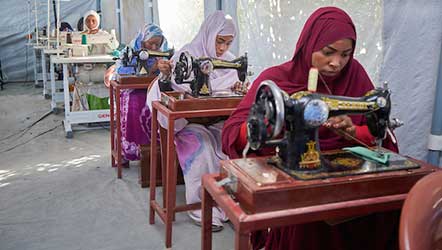
Despite significant progress in recent decades, labor markets across the world remain divided along gender lines. Female labor force participation has remained lower than male participation, gender wage gaps are high, and women are overrepresented in the informal sector and among the poor. In many countries, legal restrictions persist which constrain women from developing their full economic potential. While equality between men and women is in itself an important development goal, women's economic participation is also a part of the growth and stability equation. In rapidly aging economies, higher female labor force participation can boost growth by mitigating the impact of a shrinking workforce. Better opportunities for women can also contribute to broader economic development in developing economies, for instance through higher levels of school enrollment for girls.

Closing the gender gap in science, technology, engineering, and math would accelerate the green transition while making it more inclusive

New governors in Bosnia and Herzegovina and Papua New Guinea lifted the share of central banks with women leaders to 16 percent

Latest books provide analytical and anecdotal accounts of the greatest challenges—and the perspective that comes with time

Empowering women economically is a powerful engine of inclusive growth

A new survey reveals the gender gap persists

Capturing the dividends from women’s economic equity. Too many women are locked out of economic opportunities, which is not only unfair but also harms growth and resilience for all.
The total fertility rate—the average number of births per woman—in Europe is already at 1.46, which is significantly below the replacement rate of 2.1, where fertility compensates for mortality and thereby the population replaces itself from one generation to the next. Falling fertility rates will have far-reaching social and economic consequences, and therefore it is a critical empirical exercise to estimate the impact of below-replacement fertility on income growth and test quantitatively for the existence of mitigating factors that could inform appropriate policy responses. In this paper, I address the endogeneity bias caused by reverse causality by implementing an instrumental variable approach and use exogenous variation in the comparative abortion index as an instrument for the total fertility rate. These results show that fertility has a significant positive effect on real GDP per capita growth in a sample of 42 European countries over the period 1960–2022. This means that the downward fertility transition across Europe, accompanied by fast-aging population, is a significant drag on income per capita growth.
The Maltese authorities have made significant progress towards gender equality over the last two decades. Supportive government policies and a steady inflow of foreign labor have played a key role in increasing women’s participation in the labor market. In addition, the attainment of higher education levels and skills have significantly improved. Meanwhile, women’s representation in senior public and private sector positions still lags behind that of men. An empirical study using microdata from the labor force surveys indicates that while the overall gender income gap has decreased over the last decade, gender income gaps remain pervasive in Malta.
This paper explores the relationship between violent conflicts and gender inequality in a global sample since the 1990s. Based on a composite index, it shows that conflicts, including both interstate and intrastate events, predict a higher gender inequality in outcomes. Focusing on specific gender outcomes, school enrollment rate by females in primary education and share of seats in parliament held by women tend to decrease in the aftermath of those episodes, whereas maternal mortality rate increases. Moreover, conflicts tend to widen cross-country gaps in gender inequality in outcomes. Focusing on gender inequality in opportunities, conflicts are associated with lower economic rights for women in legislation. Considering the role of women’s empowerment in economic growth and development, these associations between conflicts and gender inequality provide a channel for the observed, long-lasting drag on economic performance following those episodes. The ongoing political and security-related challenges across the globe make the implications of the findings even more crucial for sustainable and inclusive economic growth in the post-Covid-19 era.
Kosovo’s female labor force participation ranks among the lowest globally, resulting in a substantial gender participation gap. This paper examines the drivers of this phenomenon and estimates the potential economic gains from eliminating this disparity. Additionally, it introduces a framework using non-parametric methods to estimate the gender wage gap in Kosovo’s labor market.
Jordan continues to show resilience and maintain macro-economic stability, thanks to the authorities’ sound macro-economic policies and reforms. However, as the conflict in the region continues and widens, it is having a larger impact on Jordan’s economy than anticipated at the outset of the program.

Closing the gender gap in science, technology, engineering, and math would accelerate the green transition while making it more inclusive

New governors in Bosnia and Herzegovina and Papua New Guinea lifted the share of central banks with women leaders to 16 percent

Latest books provide analytical and anecdotal accounts of the greatest challenges—and the perspective that comes with time

Empowering women economically is a powerful engine of inclusive growth

A new survey reveals the gender gap persists

Capturing the dividends from women’s economic equity. Too many women are locked out of economic opportunities, which is not only unfair but also harms growth and resilience for all.
The total fertility rate—the average number of births per woman—in Europe is already at 1.46, which is significantly below the replacement rate of 2.1, where fertility compensates for mortality and thereby the population replaces itself from one generation to the next. Falling fertility rates will have far-reaching social and economic consequences, and therefore it is a critical empirical exercise to estimate the impact of below-replacement fertility on income growth and test quantitatively for the existence of mitigating factors that could inform appropriate policy responses. In this paper, I address the endogeneity bias caused by reverse causality by implementing an instrumental variable approach and use exogenous variation in the comparative abortion index as an instrument for the total fertility rate. These results show that fertility has a significant positive effect on real GDP per capita growth in a sample of 42 European countries over the period 1960–2022. This means that the downward fertility transition across Europe, accompanied by fast-aging population, is a significant drag on income per capita growth.
The Maltese authorities have made significant progress towards gender equality over the last two decades. Supportive government policies and a steady inflow of foreign labor have played a key role in increasing women’s participation in the labor market. In addition, the attainment of higher education levels and skills have significantly improved. Meanwhile, women’s representation in senior public and private sector positions still lags behind that of men. An empirical study using microdata from the labor force surveys indicates that while the overall gender income gap has decreased over the last decade, gender income gaps remain pervasive in Malta.
This paper explores the relationship between violent conflicts and gender inequality in a global sample since the 1990s. Based on a composite index, it shows that conflicts, including both interstate and intrastate events, predict a higher gender inequality in outcomes. Focusing on specific gender outcomes, school enrollment rate by females in primary education and share of seats in parliament held by women tend to decrease in the aftermath of those episodes, whereas maternal mortality rate increases. Moreover, conflicts tend to widen cross-country gaps in gender inequality in outcomes. Focusing on gender inequality in opportunities, conflicts are associated with lower economic rights for women in legislation. Considering the role of women’s empowerment in economic growth and development, these associations between conflicts and gender inequality provide a channel for the observed, long-lasting drag on economic performance following those episodes. The ongoing political and security-related challenges across the globe make the implications of the findings even more crucial for sustainable and inclusive economic growth in the post-Covid-19 era.
Kosovo’s female labor force participation ranks among the lowest globally, resulting in a substantial gender participation gap. This paper examines the drivers of this phenomenon and estimates the potential economic gains from eliminating this disparity. Additionally, it introduces a framework using non-parametric methods to estimate the gender wage gap in Kosovo’s labor market.
Jordan continues to show resilience and maintain macro-economic stability, thanks to the authorities’ sound macro-economic policies and reforms. However, as the conflict in the region continues and widens, it is having a larger impact on Jordan’s economy than anticipated at the outset of the program.
The IMF's gender-focused events explore the role of gender equality in economic growth. These discussions offer insights into overcoming gender gaps, showcasing strategies that benefit women, families, and the global economy.

In an era marked by rapid technological advancement and shifting global economic landscapes, the imperative for inclusive growth and gender equality has never been more critical.

Managing Director Kristalina Georgieva and World Food Programme Executive Director Cindy McCain discussed their personal career journeys, investing in women and girls, and more.

Kristalina Georgieva, Melinda French Gates, Hon. Zainab Ahmed, and Sima Sami Bahous discussed how the IMF, governments, and others can work together to help reduce gender gaps.

Senior Advisor on Gender joined a panel discussion on the future of global population growth, and the pressures and opportunities it presents for women and girls.

Discussion on why more women are needed in the financial sector, especially in leadership positions, and how this can help with financial sector stability and inclusive growth.

"Gender Equality Boosts Economic Growth and Stability:" remarks by Gita Gopinath, IMF First Deputy Managing Director, delivered at the Korea Gender Equality Forum.

At the Center for Global Development, IMF's Ratna Sahay presented the recently approved IMF Strategy Toward Mainstreaming Gender, followed by a panel discussion.